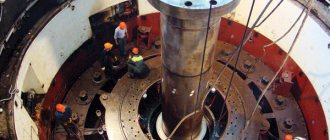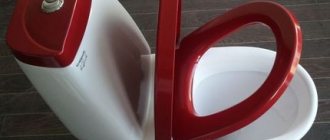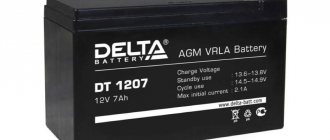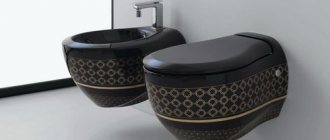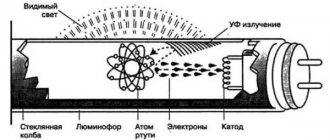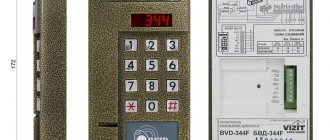Read also
Hydraulic machines, bridges, channels, machines for their creation and devices for diving under water
Hydraulic machines, bridges, canals, machines for their creation and devices for diving under water Leonardo's diving suit Long before Leonardo, inventors and scientists were interested in the possibility of a person diving to a significant depth. Leonardo, whom
Automatic machines and other “working” machines
Automatic machines and other “working” machinesVertical saw This project was discovered in the Atlantic Codex, which contains the main drawings of the Master’s machines and mechanisms. It is not known whether Da Vinci invented this machine for sawing logs or only improved it -
"DYNAMO"
"DYNAMO" "Dynamo" is a proletarian sports society of troops and employees of the GPU, in essence one of the subdepartments of the GPU - an institution disgusting to the highest degree, even by Soviet standards. Officially, it is engaged in the physical training of security officers,
DYNAMO IS MELTING
DYNAMO MELTING AT the end of May, our convict-privileged position in Medgor was consolidated approximately to the extent that this is generally possible in the fluidity of Soviet destinies, and I (an optimistic person!) began to be imbued with confidence that our escape, at least
Dynamo is scandalous
“Dynamo” scandalous In August 1976, the Dynamo football team from Kyiv was at the center of two scandals at once. The first case occurred on August 14, when the people of Kiev were supposed to play in Donetsk against the local Shakhtar. However, the people of Kiev arrived in Donetsk with incomplete
"DYNAMO"
“DYNAMO” Mikhail Yakushin in the game was (with which of the footballers of later times can he be compared in style and tactical manner?), perhaps, like the Brazilian Socrates. And from ours - like Yuri Gavrilov in the prime of his strength and skill (although, if you look at it, Yakushin played better
CHAPTER V. INVENTION OF THE STEAM ENGINE
CHAPTER V. THE INVENTION OF THE STEAM ENGINEAccording to Watt himself, from the time when the University of Glasgow entrusted him with correcting the model of the steam engine, which happened in the winter of 1763, he almost never had to deal with the use of steam. True, in 1759 Robison, then still
Invention of cracking
Invention of cracking Many of Shukhov’s achievements can be characterized by the words “first in the world” - often his innovative inventions gave rise to entire areas of science and technology. 1891. Increasing use of internal combustion engines
First invention
First invention Vasily Degtyarev worked at the Sestroretsk plant for about six years, but he had almost no friends. Due to the secrecy of the task, he had to work alone and avoid unnecessary acquaintances and communications. He knew that there were secret secrets at the plant
Juan's invention
Juan's inventionI hold four crumpled pieces of lead in my palm. If they had gotten on my plane yesterday, I would have been in trouble. But today I only felt a small dull knock behind me and during the battle I didn’t attach much importance to it. Juan is very pleased: “It’s good that we came up with this
First invention
The first invention Father was noticeably weakening. Exhaustive long hours of work brought him to the grave while still relatively young. The whole burden of supporting a large, grief-stricken family fell upon me, a seventeen-year-old youth. By that time I was already an experienced worker, but with
FIRST INVENTION
FIRST INVENTION Vasily Degtyarev worked at the Sestroretsk plant for about six years, but he had almost no friends. Due to the secrecy of the assignments, he had to work alone, avoiding unnecessary acquaintances. He knew that there were secret revolutionary circles at the plant,
Etymology[edit]
The word dynamo
(from the Greek word dynamis (δύναμις), meaning force or power) was originally another name for an electrical generator, and still has some regional usage as a replacement for the word generator. The word was coined in 1831 by Michael Faraday, who exploited his invention toward making many discoveries in electricity (Faraday discovered electrical induction) and magnetism.[1][2]
The original “dynamo principle” of Werner von Siemens referred only to the direct current generators which use exclusively the self-excitation (self-induction) principle to generate DC power. The earlier DC generators which used permanent magnets were not considered “dynamo electric machines”.[3] The invention of the dynamo principle (self-induction) was a huge technological leap over the old traditional permanent magnet based DC generators. The discovery of the dynamo principle made industrial scale electric power generation technically and economically feasible.After the invention of the alternator and that alternating current can be used as a power supply, the word dynamo
became associated exclusively with the
commutated direct current electric generator
, while an AC electrical generator using either slip rings or rotor magnets would become known as an alternator.
A small electrical generator built into the hub of a bicycle wheel to power lights is called a hub dynamo, although these are invariably AC devices,[ citation needed
] and are actually magnetos.
Tail light circuit with dynamo.
- Old relay
- Coil Contacts
- Mounting screw
In order not to waste time assembling the coil with your own hands, it is better to try to find some old relay. I took the panel in the picture above from an old PBX. The second picture shows a coil from a disassembled relay.
The coil resistance should be between 100 and 200 ohms. The resistance of the coil shown in the figure is 200 ohms. The higher the coil resistance, the more energy is generated, but at the same time the efficiency decreases due to increased losses in the coil.
- Stainless steel
Next, you will need to remove the neodymium magnets from the hard drive. My rear wheel dynamo uses three of these magnets, but you can use many more if you are able to mount them securely.
An example of the use of chargers in tourism
You can use many different devices to charge your navigator, phone and camera. Hand dynamos, solar panels, Powerbanks and hub dynamos for bicycles.
The last one is the most effective, but first things first.
Hand-held dynamos are no longer needed; too much time is spent spinning aimlessly.
If it were still silent, it could be combined with contemplation of nature, listening to the stream, birds, and the rustle of the wind. But the buzzing interrupts all the surrounding sounds, and this is mentally very tiring.
The solar battery is quite good, but it comes with a PowerBank, this is the first disadvantage. Second, it is quite fragile and needs to be placed at the very top of the bag.
In bike touring, this is not always the ideal location.
Unfortunately, it is impossible to completely prevent the bicycle from falling, and the first unsuccessful fall will certainly damage the solar battery. This is what actually happens in cycling tourism.
And small, compact PowerBanks with a solar panel are ineffective; you can get too little electricity. And on a cloudy day, the efficiency of such a device drops.
A hub dynamo for bicycles is also, unfortunately, not an ideal device. She has one small drawback. About 3 to 5% of the torsional energy is used to create electricity.
If you go on a straight road or go downhill, it doesn't matter. And if you climb a long hill, it can be an unpleasant experience.
Top articles: Bicycles with driveshaft
But there is a simple and effective solution. When climbing a hill or steep climb, temporarily disable the hub dynamo.
When idling, it does not create additional resistance, but for the cyclist, this 5% allows you to climb more comfortably.
By charging gadgets in this way, you do not take additional ballast with you; the hub on the wheel continues to perform its main function, plus it also acts as an energy generator.
DIY dynamo, its elements
In order to build a dynamo, you will need such basic elements as a housing, a rotating armature, a commutator, a brush holder, brushes, and insulated copper wire.
Let's consider the preparation of each element separately.
| Dynamo device | |
| There are different options for making the case. A tin can or a piece of pipe (diameter 100 mm) is suitable for it. First, you need to cut out the bottom of the can and weight the body. To do this, wrap a strip of iron of the same width very tightly in several rows on the inside or outside of the can. Then we rivet or solder the strip to the body. Secondly, we make cores for electromagnets and shoes for them from tin or iron. We take strips of tin along the width of the body, bend them, place them on top of each other, fasten them with iron wire and solder them along the sides. We attach the cores to the holes in the housing located opposite each other. Using screws, screw the body to the block (wooden or metal). In the housing we make two bearing strips (brass or thick sheet metal, size 110x20 mm) and a stand (80x20 mm) to secure the armature. We solder the strips in a cross pattern and make a hole in the center along the diameter of the axis. The same hole in the rack 10 mm from the end. Copper tubes (10-15 mm with a diameter of 8 mm) can be soldered into the bearing holes. We solder the first bearing to the body with the ends of the strips, after which the system will bend outward. |
| The anchor must be made carefully, since it largely determines how the dynamo will work. You can assemble an anchor from tin plates. The thickness of all plates must be equal to the thickness of the body (50 mm); their manufacture requires special precision. Approximately 120 circles (46 mm in diameter) will have to be cut out of iron. We divide each circle into eight sectors using a compass, make markings through the center of the circle, and in the center of the circles we draw two circles with a diameter of 8 and 38 mm. At the intersection of the large circle with the sector lines, we draw another 8 mm circles. On all round plates, where the circles are drawn, we accurately drill eight 8 mm holes. We tightly fasten the plates with nuts and put them on the axle, you should get an anchor with round longitudinal grooves. We round off sharp corners in the grooves with a file. |
Who invented the dynamo and how does it work?
In 1831, the English physicist Faraday discovered an unusual electromagnetic phenomenon. An electromagnetic field arose in the copper wire during rotation between the magnetic poles. It was this that excited the movement of electrons along the conductor. Based on research, the physicist formulated the law of electromagnetic induction. The conductor was a copper wire wound onto a metal rod with a magnetic property. When the magnetic particles in the rod aligned with the poles, it turned into a magnet and attracted metal objects to itself. To magnetize the rod, you can use a coil or a permanent magnet. The effect occurs when one electromagnet rotates strongly around another.
In the same year, a device for converting electrical energy into mechanical energy appeared. The first electric motors resembled steam engines: only electromagnets were installed instead of cylinders, and metal armatures were installed instead of pistons.
In 1834, Russian academician Boris Jacobi created the first electric motor with a rotating armature. Four years later, the academician used an improved electric motor on the world's first motor boat. The world's first alternating current generator was built by Pavel Yablochkov. And the invention of another Russian scientist M. Dolivo-Dovolsky - a three-phase current generator - was truly revolutionary.
Take the traffic rules knowledge test for a cyclist!
0 out of 15 tasks completed
Questions:
- 1
- 2
- 3
- 4
- 5
- 6
- 7
- 8
- 9
- 10
- 11
- 12
- 13
- 14
- 15
Information
To be able to obtain rights, please click Next
You have already taken the test before. You can't start it again.
The test is loading...
You must log in or register in order to begin the test.
You must complete the following tests to start this one:
Correct answers: 0 out of 15
Your time:
Time is over
You scored 0 out of 0 points (0)
- Please write in the comments if you liked the test. Should things like this be added to the site? What would you like to see on the site?
Thanks in advance for your feedback!
maximum of 15 points
| Place | Name | Recorded | Points | Result |
| Table is loading | ||||
| No data |
Your result has been recorded in the leaderboard Loading
Name: Email: Captcha:
- 1
- 2
- 3
- 4
- 5
- 6
- 7
- 8
- 9
- 10
- 11
- 12
- 13
- 14
- 15
- With answer
- With a viewing mark
- Task 1 of 15
Are the Rules broken in the situations depicted?
- Only in the first picture
- Both are violated
- Both are not violated
Only in the second picture
Correct 6. Requirements for cyclists
6.6. A cyclist is prohibited from:
d) while driving, hold on to another vehicle;
f) tow bicycles;
Wrong 6. Requirements for cyclists
6.6. A cyclist is prohibited from:
d) while driving, hold on to another vehicle;
f) tow bicycles;
Winding
For the winding we will use copper wire with paper insulation with a cross section of 0.5-0.8 mm. You need to purchase half a kilogram of wire, the thickness of which will affect the voltage and current. For example, when winding with 0.5 mm wire, 25 volts will be generated at a current of 1 ampere, if you take a wire of 0.8 - 8 volts at a current of 3 amperes. Before starting work, divide the wire into two parts. To wind the electromagnet you will need 450 g of 0.5 wire and 60 g for the armature winding. If you bought 0.8 wire, we will set aside 430 g for the electromagnet, and 70 g for the armature.
Operating principle of an electric current generator
A dynamo generates electrical energy through the principle of electromagnetic induction. Typically, such a device converts mechanical influences directly into electrical impulses. It consists of a rotor (an open wire winding) and a stator in which the poles of the magnet are located. The rotor, without stopping its movement, rotates all the time in a force magnetic field, which inevitably leads to the generation of current in the winding. The dynamo represents the following diagram of its device. A rotating conductor, or rotor, crosses a magnetic field and a current is generated in it. The ends of the rotor are connected to the ring (collector), through them and the pressure brushes the current moves into the electrical network.
Bicycle dynamo
A small generator for a bicycle is mounted on the side wall of the tire. It allows you to charge the batteries of mobile phones, receivers and other devices, and lights up the headlights. A bottle dynamo is also called a side dynamo. When driving, the tire drives the dynamo roller, which rotates the electric generator.
For a bicycle generator, you can take a dynamo hub or a dynamo carriage. A non-contact dynamo will also work. She will be able to charge the phone quite successfully.
- A bottle generator creates resistance when running and requires more effort to turn than a hub dynamo. Proper adjustment will help reduce resistance.
- When wet, the dynamo bottle roller may slip over the tire, which will significantly reduce the amount of energy produced.
- A hub dynamo does not require good grip and sealing. They do not make noise like dynamos.
A bottle bike dynamo wears out the tire, unlike a hub dynamo.
Principle of operation
A good light is bright enough to be visible, illuminates the road without blinding others, and stays bright while you're stopped at a traffic light.
Most dynamic lighting products are designed in accordance with German road traffic regulations (StVZO/TA). These strict and specific rules are in place to ensure that cyclists are well lit on all sides and that the lights do not interfere with other traffic.
The headlight must have a horizon, which means the beam of light is limited by the cap at the top and directed so that the center of the beam hits the ground 33 feet (10 meters) from the front of the bike. The concentrated beam illuminates dangerous areas on dark streets without blinding oncoming motorists and cyclists.
Flashlights should also have a backlight function, a built-in capacitor that continues to power the flashlights for four minutes once you stop moving. This feature ensures that you remain visible when stopped at intersections.
In most countries, cyclists are required to have a white light at the front and a red light at the rear. One dynamo can power both the front and rear lights. Equally bright battery-powered lights only last 1-3 hours before needing to be recharged.
Dynamo systems provide plenty of light and can be adapted to different riding styles. When choosing a dynamic lighting system, you need to consider both brightness and beam structure.
Brightness is usually described in two different units: lumens and lux. While battery-powered lamps are usually rated in lumens, dynamo lamps are most often rated in lux. While lumens are a measure of the total amount of visible light emitted by a source, lux is a measure of the intensity of light in the usable portion of its radiation pattern. This means that two light sources with the same brightness ratings can have very different lux measurements, depending on how the light is focused.
You may be interested in: Set of hexagons for a bicycle: how to choose
Dynamo charger
In field conditions, a simple “twist” or dynamo for charging your phone is always useful. Chargers with a built-in battery are popular. There are mechanical chargers that also do not take up much space. Many modern “spinners” are equipped with flashlights.
These devices charge mobile phones quite successfully. For example, when rotating the knob 2-3 revolutions per second, you can get a coefficient value from 0.65 to 2.5. Spin it for a couple of minutes and you can talk on the phone for 2 to 5 minutes. It all depends on the model and reception conditions. A handheld dynamo will not be able to power a powerful smartphone with a large display. Mechanical charging will provide results in conjunction with a simple phone along with a hands-free headset.
Dynamo charging will work effectively when the battery is completely discharged, but you can only increase the phone’s charge by twisting the handle up to 50%. When the battery is only half discharged, the spinner becomes a useless toy. If the instructions indicate a maximum charging current of 400 mA with a power of 2 W, then it will not be possible to squeeze out additional energy even if you quickly rotate the handle.
Dynamo (Bike Generator). Types and features. Job
An electrical energy generator is a device that converts chemical, mechanical or thermal energy into electrical current. Such a generator, used on bicycles to power the rear lights and headlight, is a dynamo.
Varieties
Let's consider the existing types of factory-made bicycle dynamos.
Bottle shop
This type of bicycle generator is the most affordable and simple. However, its power is not the greatest of all types. The generator drive roller rotates by touching the tire tread while driving.
Bush Dynamo
The hub dynamo is an axial dynamo in its design. Executions of such models can be of various types. The cost of a bushing generator is quite high. Installation is more complicated compared to the bottle version.
When purchasing, you must check the number of spokes and the method of fixing the installation wheel. The advantages of a bushing generator include its protection from moisture, unlike a bottle generator, the drive roller of which slips over the bicycle tire in wet weather. The device is enclosed inside the wheel hub, and the work comes from its rotation.
The disadvantages of such a device include the fact that it is not possible to turn off the operation of the bushing generator.
Chain
The chain version of a bicycle generator is quite rare. However, there are several different versions of this type. The device can be equipped with a USB port for charging mobile gadgets.
The disadvantage of this design is its short service life, since during operation the metal bicycle chain impacts the plastic elements of the generator.
Contactless
This is an original dynamo with a non-contact operating principle. The bicycle wheel plays the role of a rotor. A special hoop with 28 magnets is attached to the wheel. They are arranged alternately, with different poles.
The stator is an induction coil in which electric current is generated. This system includes a battery for energy storage. According to the manufacturer, to ensure normal light flux, it is enough to move at a speed of 15 km per hour.
The advantages of this design are:
- No rubbing elements.
- Quiet operation.
- Unlimited service life (except for batteries).
The disadvantage of the contactless model is the low battery capacity. It only lasts a few minutes. However, many craftsmen easily correct this drawback in various ways, including replacing the battery with a more powerful one.
Other designs
Currently, various interesting devices that are made in China are very popular. Sometimes you see devices that have never been produced anywhere before. Even their operating principle is not always clear, but they work.
This Chinese device can easily be called the bicycle generator of the future. The dynamo from heaven looks similar to science fiction films. Judging by its appearance, it does not require contact with the wheel bar or chain to function. There are also no magnets.
The principle of its operation is not entirely clear. Perhaps this is a technological secret of the manufacturer.
Design features and operation
The most popular dynamo design on bicycles is the bottle design, followed by the hub dynamo. Other types are used much less frequently. Therefore, we will consider the most common models.
Dynamo bottle
The bottle-type dynamo runs on the side of the front tire of a bicycle. It is made in the form of a small generator of electrical energy, and is used to operate the rear light and front headlight of a bicycle, as well as charge electronic mobile devices.
Such a mini-generator can be mounted on both the front and rear wheels. In the first case, the device can be combined with a built-in flashlight. To turn off the generator, a special folding mechanism is provided, which fixes the generator housing in a position where there is no contact with the bicycle wheel tire.
The name of this device comes from the external resemblance of the shape to a bottle. The bottle generator also has another name – side dynamo. The drive rubber or metal roller is driven into rotation on the side of the wheel tire. When the bicycle moves, the tire imparts rotational motion to the bicycle generator roller, which generates an electric current.
Advantages
- When the generator drive is turned off, there is no resistance to the movement of the bicycle. When the generator is turned on, the cyclist has to apply more force to move. A hub dynamo, unlike a bottle bicycle generator, always resists wheel rotation, although the value of this resistance is insignificant. If the bottle generator is turned on, but the lights and headlight are not connected to power, then the resistance to the movement of the bicycle is less.
- Easy and simple installation. Such a device is easy to install on any bicycle, unlike a hub generator, the installation of which requires the assembly of the entire dynamo wheel with spokes.
- Low cost. These models usually cost less than other types of bicycle generators, although there are exceptions to this rule.
Flaws
- Difficult setup. Careful adjustment and adjustment of the wheel's contact with the tire at a certain angle, tire pressure, and height is required. If the bike is dropped or the retaining screws become loose, the alternator may be damaged. An incorrectly adjusted generator device will make a lot of noise, create excessive resistance, and slip on the wheel. If the fastening screws are too loose, the mechanism may move out of place and get caught in the wheel spokes, which will lead to broken spokes and failure of the bicycle wheel. Some bicycle generators are equipped with special loops that prevent them from getting into the spokes.
- Switching requires physical effort. To activate the generator, it is necessary to move its housing until it comes into contact with the wheel. Bushing generators can be switched on automatically or electronically. You don't need to put any effort into this.
- Increased noise. During operation, a humming noise is heard, while hub dynamos do not create noise.
- Wheel tire wear. To operate the generator, contact with the tire is required, resulting in friction and tire wear. If you compare it with a dynamo hub, there is no friction with the tire.
- Resistance to movement. A bottle dynamo offers significantly more resistance to the bike's movement than a hub model. However, when configured correctly, the resistance is negligible, and when switched off, there is no resistance.
- Slipping. In wet, rainy weather, the drive roller of the bottle generator will slide on the tire tire, which reduces the generation of electric current and reduces the brightness of the headlight and taillight. Hub generators do not require good tire grip to operate and are not affected by weather or other adverse conditions.
Dynamo hub
The hub design of the bicycle generator was developed in England and produced by various companies in many countries. The power of this design can reach 3 watts at a voltage of 6 volts. Their manufacturing technologies are constantly being improved, the dimensions of the structure are becoming smaller and more powerful. Modern bicycle headlights now produce more efficient light due to the use of LEDs and halogen lamps.
Hub dynamos do not create noise during operation, but their mass is greater than that of other models. There are no rubbing parts in the sleeve version of the device. They operate due to a magnet having many poles and made in the form of a ring. It is located in the bushing body and rotates around a stationary armature with a coil fixed on the axis. The rotational resistance of this design is very low.
Hub dynamos produce alternating current. At low speeds, more electricity is generated compared to the bottle model due to the low frequency of the current. There are rectifier circuits for a dynamo. They are made using a simple bridge circuit of four diodes.
The hub dynamo produces a low voltage, so when using silicon diodes the losses are significant - 1.4 volts. With germanium diodes, losses are reduced and amount to only 0.4 volts.
Working principle of a dynamo
A dynamo produces electric current using the effect of electromagnetic induction. The rotor rotates in a magnetic field, resulting in an electric current in the winding. The ends of the rotor winding are connected to a collector made in the form of rings. Through them, with the help of pressing brushes, electric current enters the network.
The current in the winding has a maximum value if the rotor is perpendicular to the magnetic lines. The greater the angle of rotation of the winding, the less current. Rotation of the winding in a magnetic field changes the direction of the current twice in one revolution. Therefore, the current is called alternating.
A similar generator for direct current is made on the same principle. The difference is in some details. The ends of the winding are connected not to rings, but to half rings, which are isolated from each other. When the winding rotates, the brush contacts each half ring in turn. Therefore, the current flowing to the brushes will have only one direction and will be constant.
Source
Powerful DIY generator
A powerful electricity generator can be assembled using an old bicycle without eights on the rear wheel. A 28-inch wheel and a 52-tooth front sprocket will do, but other options are possible, such as a 26-inch and a 46-tooth sprocket. First of all, we remove unnecessary parts: the front wheel, tires, gear shift, brakes. Place the bike on the stand.
The generator must be self-contained with two large terminals and one small one. We connect the two large terminals together to form a plus, and the small one with an indicator light. We connect the grounding terminal to the housing (minus). We clean the generator and remove the cooling fan from it. We fix the generator on a bracket behind the seat, the spindle should be outside 10-12 cm from the rim. We select a belt, preferably a toothed one, with a circumference of approximately 82 inches. For 26" wheels, A78 belts are suitable, and for 27" wheels - A80.
To adjust the tension of the alternator, we use a spring-type tensioner. The belt does not need to be tightened too much as the torque is quite low. We attach a voltmeter, a switch and a light bulb to the steering wheel. If there are children in the house, it is necessary to protect the moving parts of the mechanism to eliminate the possibility of injury.
Hub dynamo installation
There are no difficulties when installing a bottle generator, but a hub generator for a bicycle will make you work.
First of all, since the design of such a generator itself provides for installation as a supporting bushing, the wheel will have to be removed and completely disassembled. Take care of a set of shortened knitting needles first. After complete disassembly, use short spokes to secure the rim to the hub. Try to install it evenly and evenly, gradually tightening the spokes, and then tightening it to finally strengthen the rim. Then you need to balance and check for runout and imbalance.
Firstly, this is a ready-made alternator, which is designed to work as a bicycle wheel hub, generating electricity for the headlight, which means that it is low-speed, since the bicycle wheel spins up to a maximum of 300 rpm when riding. The dynamo hub reaches its rated power at a speed of about 15 km/h, and begins to produce current from almost zero speed of 5-7 km/h.
The peculiarity of this generator is that it is not the shaft (rotor), but the housing (stator) that rotates here, but this even has some advantages, since you can fasten it with one bolt to the shaft, and the blades directly to the housing. Also, the weight of the dynamo hub is only about 400g.
Initially, the hub dynamo produces an alternating voltage, but to charge the batteries you need a constant voltage, so you can even assemble a diode bridge without using a soldering iron; it rectifies the voltage.
Having twisted the dynamo hub, I was surprised at how much voltage it can produce; at a nominal 6 volts, it turns out that you can easily spin it up to 30 volts by hand, which means that it can charge not only two or three AA batteries, but also a 12-volt battery, and even 24 volts, which I have tested in practice. But the maximum current is 520mA. , after this threshold, specifically in my dynamo hub, the internal protection is triggered and the power is turned off until the current drops. This is probably done to prevent the light bulb in the headlight from burning out at high speeds of the bicycle. The photo shows a table of scrolling of the hub dynamo at various speeds.
>
By the way, don’t be afraid to charge batteries from this speaker, high voltage will not harm them, they will level it out to their own. For example, if you turn the speaker to at least 30 volts and connect a 12-volt battery, the voltage will immediately drop to 12 volts and will gradually increase as it charges to 13 volts; when it reaches 14 volts, the battery should be disconnected so as not to overcharge, this is harmful, although The generator has a weak current, but still.
Best articles: Bicycles of the USSR: popular models of a bygone era
The hub dynamo is a single-phase permanent magnet generator, due to the fact that it is single-phase it has significant disadvantages, such as a lot of sticking, which prevents small propellers from starting in low winds, and humming and vibration along the mast during operation. Therefore, I made a large screw for this generator, with a diameter of 1.6 m. I first placed the mast at my country house, but the vibrations from the generator were transmitted through the mast and made a buzzing sound in the house, as if a car was driving nearby somewhere, and I moved the mast further away from the house. This vibration is inherent in all single-phase permanent magnets, such as stepper and dynamo bushings and the like, and this is the most significant disadvantage for me, but for example, three-phase generators do not have this disadvantage, so in the future I made them.
>
In the photo I roughly drew the main parts of the wind generator and the method of attaching the generator, this drawing is from my other site (Hermits, life in the wilderness). The wind generator was assembled as a camping one, so that it could be easily transported in a backpack, easily installed in a parking lot, and charged with everything you needed. The photo shows a wire from a windmill, then a converter (a diode bridge to rectify the voltage), a controller that I made from a phone charger, but I never used it, but charged the batteries simply by monitoring the voltage from time to time with a multimeter.
Conclusion, the dynamo sleeve is a good generator for a micro windmill, and not only, it will also make a good manual charger for small batteries and a phone. It’s also light and convenient, at least I didn’t feel sorry for the money I spent on it, plus I had initial experience in building wind turbines.
